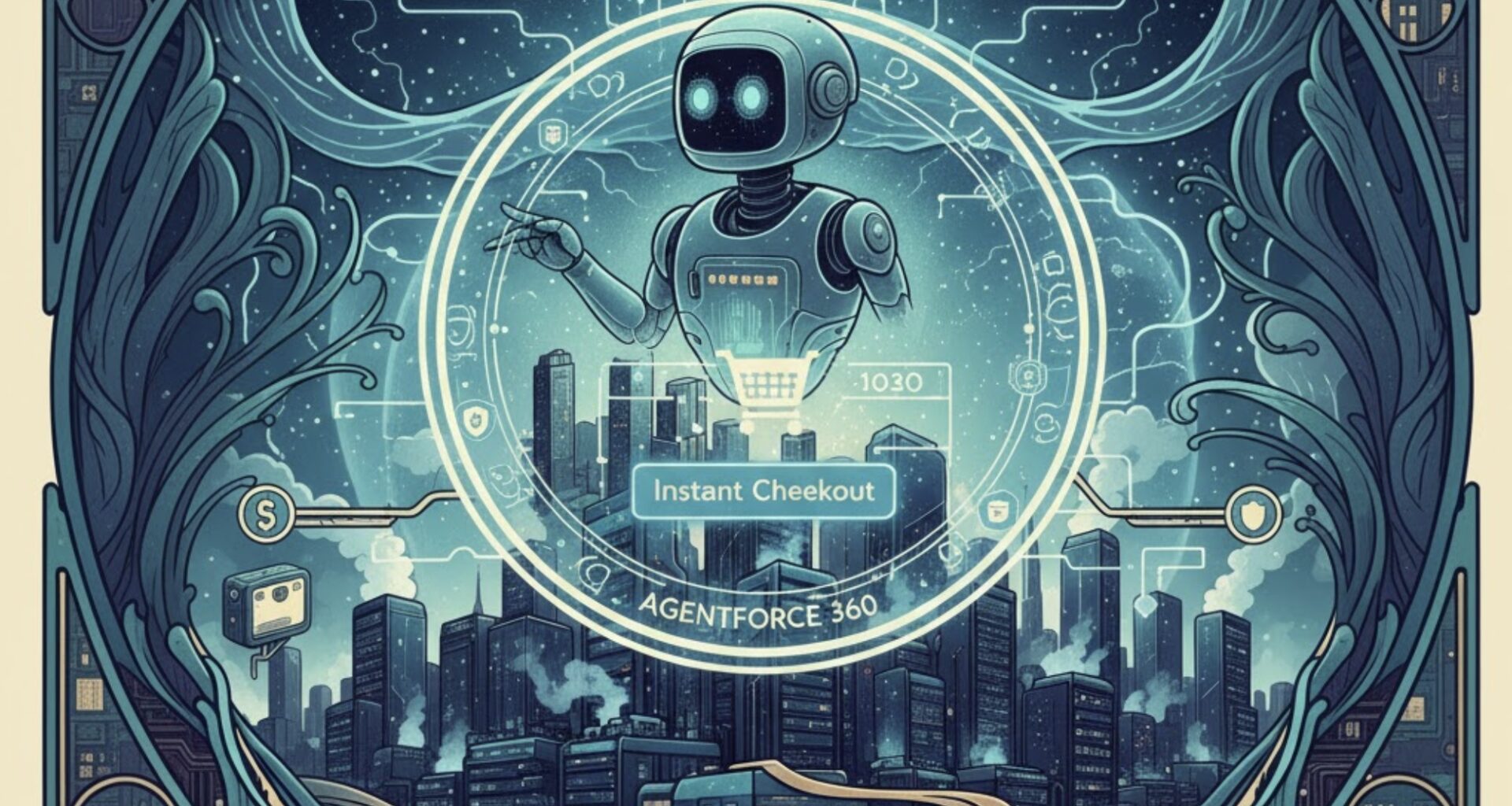On October 14, 2025, Salesforce announced a new collaboration with Stripe and OpenAI to integrate an Instant Checkout experience—based on the newly minted Agentic Commerce Protocol (ACP)—into Salesforce’s Agentforce Commerce (part of its broader Agentforce 360 initiative). Stripe+3Salesforce Investor Relations+3Salesforce Investor Relations+3
Under this partnership:
- Merchants using Agentforce Commerce can expose their product catalogs inside ChatGPT (or other AI agents). Salesforce Investor Relations+2Salesforce Investor Relations+2
- Users within ChatGPT can make purchases right where they’re discovering a product—“in-chat” or “in-agent”—via Instant Checkout, powered by Stripe and the ACP. Stripe+3Salesforce+3Stripe+3
- The agentic architecture ensures that merchants retain control over brand, fulfillment, customer relationships, and data. Salesforce Investor Relations+2Stripe+2
- Stripe’s contribution includes a payment framework (notably Shared Payment Tokens) that enables agents to transact on behalf of users without exposing raw payment credentials. Stripe+3B2B eCommerce Association+3Stripe+3
It’s early days—some features are in private preview. But the move signals a deliberate push toward a more agent-centric commerce paradigm. OpenAI Developers+4Stripe Docs+4OpenAI Developers+4
What is the Agentic Commerce Protocol (ACP)?
To understand the significance, we need to unpack the ACP.
Purpose & vision
ACP is an open standard (Apache 2.0) co-developed by Stripe and OpenAI, intended to define how AI agents, buyers, and merchants can interact in a standardized, secure, and interoperable way. agenticcommerce.dev+4Stripe+4OpenAI Developers+4
Key goals include:
- Seamless transitions from discovery to purchase inside an AI-powered interface (like ChatGPT)
- Trust and security, so that agents can transact on behalf of users without exposing sensitive credentials
- Merchant control, so sellers remain “merchant of record” and retain brand, fulfillment, and customer data responsibilities
- Interoperability, so one merchant-side implementation can speak with many agents (and vice versa) without bespoke integrations for each pair
Stripe states: “Instant Checkout is powered by the Agentic Commerce Protocol (ACP), … enabling programmatic commerce flows between buyers, AI agents, and businesses.” Stripe+2Stripe+2
The specification includes endpoints and interaction models (REST, webhooks, etc.) that merchants (or their platforms) can adopt. Stripe+3Stripe Docs+3GitHub+3
Core primitives & flows
While the full spec is nontrivial, here’s a simplified view of how an agentic commerce transaction might unfold under ACP:
- Discovery / catalog exposure
- The merchant publishes a product feed / catalog endpoint conforming to ACP.
- AI agents (e.g. ChatGPT) can query or index that feed.
- Checkout initiation
- The agent constructs a checkout request (with product, pricing, shipping, taxes) via an ACP “checkout” endpoint.
- The merchant validates, calculates totals, enforces logic (inventory, pricing errors), and returns a checkout session or error.
- Payment delegation
- To avoid giving the agent direct access to raw card numbers, ACP supports delegated payment flows (e.g. using Shared Payment Tokens) whereby the agent is authorized to use a token within scopes (e.g. amount, merchant, timing).
- The merchant or payment infrastructure (e.g. Stripe) processes the payment under the merchant’s account.
- Confirmation / fulfillment / updates
- The agent is notified of success, failure, or required follow-up (e.g. address verification).
- The merchant handles order fulfillment, shipping, returns, and customer service as usual.
Because ACP is open, merchants and agent developers can build to the same standard. agenticcommerce.dev+4GitHub+4OpenAI Developers+4
There is a reference implementation, spec repo, and documentation available publicly. Stripe Docs+3GitHub+3OpenAI Developers+3
Differences from traditional e-commerce or API checkouts
- Agent as intermediary — Rather than redirecting users to a web checkout, the agent directly invokes the checkout protocol.
- Scoped credentialing — Agents act with limited, governed permissions (via tokens), not full access to user financial data.
- Seamless UX — Discovery → checkout → confirmation all occur without manual transitions.
- Open standard vs point integrations — Merchants do not need separate hooks for “ChatGPT,” “Google Agent,” etc. One ACP implementation suffices.
- Auditability and safety — Because flows are standardized, behavior can be monitored, controlled, and audited.
Why Salesforce wants in
From Salesforce’s perspective, this is a strategic bet:
- Closing the loop on intent → purchase
- With Instant Checkout inside ChatGPT and ACP, a shopper’s discovery (e.g. “I want hiking boots”) can immediately convert to a purchase without switching apps. Salesforce+2Salesforce Investor Relations+2
- That means less friction and fewer drop-offs between browsing and checkout.
- Embedding commerce into the AI era
- As conversational AI becomes a first-class interface, having commerce embedded in that interface is a differentiator.
- Salesforce positions Agentforce Commerce + ACP as a future-proof commerce layer for enterprises. Stripe+3Salesforce Investor Relations+3Salesforce Investor Relations+3
- Strengthening value of Salesforce’s platform stack
- By integrating with Agentforce and Commerce Cloud, Salesforce can make its platform more central to merchants’ AI strategies.
- Merchants using Salesforce’s stack would have a smoother path to agentic commerce.
- Compete vs platform incumbents
- Salesforce can better compete with players like Amazon, Meta, Google, and other commerce/AI stacks by enabling merchants to reach users directly within AI.
- The open standard (ACP) reduces the risk of being locked out by a proprietary protocol.
- Control over data, relationships, and monetization
- Rather than surrendering the checkout to an agent’s native ecosystem, the merchant (via Salesforce) remains in control.
- That helps uphold margins, brand integrity, and data ownership.
In short: Salesforce wants to be the infrastructure that bridges the AI era with commerce — not just a CRM or commerce tool.
Challenges, risks & open questions
This is an ambitious undertaking. A number of technical, business, and trust hurdles must be addressed for it to succeed.
Technical & integration challenges
- Legacy systems alignment
Many merchants use complex, bespoke systems for inventory, pricing, fulfillment, returns, fraud detection, etc. Retrofitting or wrapping those for ACP might require heavy engineering. - Data and catalog hygiene
To respond dynamically via agents, product data, variants, policies, and metadata must be well-structured, up-to-date, and machine-readable. - Real-time availability & pricing
Agents expect real-time accuracy on stock, shipping, taxes. Synchronization lag or inconsistencies could break trust or lead to failed orders. - Error handling & edge cases
Handling exceptions (out-of-stock, payment failure, address issues, fraud checks) via conversational flows is harder than in a traditional UI where a user can see error messages. - Security, permissioning, fraud
Delegated tokens must be carefully scoped, audited, and revocable. Fraud detection must evolve to understand “agent-originated” flows. - Scalability and performance
As many agents may query, propose checkouts, revert, etc., the infrastructure must scale — especially for large merchants.
Business & strategic risks
- Channel conflict and margins
Merchants may worry about how revenue sharing, discounts, return flows, or commissions via agent channels compare to direct web/retail. - Customer expectations and control
If agents make purchases “on my behalf,” consumers may expect more transparency, control, or approval safeguards. - Trust and liability
Errors in agent decisions (wrong size, wrong shipping) could lead to disputes — liability models must be well-defined. - Adoption inertia
Merchants may be slow to adopt new standards, especially without clear ROI or proof cases. - Dependency on agent platforms
If ChatGPT (or another agent) becomes the dominant distribution channel, merchants risk dependency or gatekeeper risk. - Competition & fragmentation
Other companies (Google, Meta, Amazon) are also developing “agentic payments” and agent-commerce protocols (e.g. Google’s “Agent Payments Protocol”) Digital Transactions+1 Fragmentation in standards could reduce interoperability.
Trust, privacy & user experience concerns
- User consent & visibility
How will users see what their agent is doing, intervene, or audit prior actions? - Overautomation fears
There may be backlash if agents make mistakes, upsell, or commit purchases without adequate checks. - Data privacy & sharing
Agent-to-merchant flows must safeguard user data, preferences, and privacy. - Ethical considerations
Agents might favor certain merchants or monetize recommendation flows. Who ensures fairness and transparency?
What’s happening elsewhere & competitive dynamics
- Google and “Agent Payments Protocol”
Google recently announced its own open protocol for AI-mediated payments, setting up a parallel in the space. Digital Transactions+1 - Commercetools joining ACP
Enterprise-level commerce platform Commercetools has already signed on as a launch partner for ACP, helping enterprises adopt the standard more readily. PR Newswire+1 - Stripe & OpenAI’s earlier moves
Stripe’s blog lays out multiple agentic commerce initiatives, and OpenAI has already enabled “Instant Checkout in ChatGPT” for a limited subset (e.g., U.S. Etsy merchants) as early use cases. OpenAI Developers+4Stripe+4Stripe+4 - Open-source and community involvement
The ACP spec is public, open source, and designed to allow contributions: merchants, agents, and PSPs can adopt or extend it. Stripe+3GitHub+3OpenAI Developers+3 - Academic work on agentic delegation and security
Research is already emerging around secure delegation for autonomous agents (e.g. “Agentic JWT” for scoping agent actions). arXiv Also, there’s a survey comparing different agent protocols such as ACP, MCP, Agent-to-Agent protocols, etc. arXiv
So, the landscape is active and evolving quickly.
What merchants should do now (or start preparing)
If you run an e-commerce business or platform, this is a moment to think ahead. Here are steps and considerations:
- Monitor or apply for early access
ACP features like Instant Checkout are in preview. Early adopters may gain leverage or advantages. Stripe Docs+2Stripe+2 - Audit your data & systems
Make sure your product catalogs, pricing, inventory, metadata, and policies are clean, well-structured, and API-friendly. Transform legacy systems to support real-time queryable endpoints. - Modularize backend logic
Isolate business logic (inventory rules, pricing, promotions) so that an agent-driven checkout invocation can call into it reliably. - Design graceful conversational fallback logic
Anticipate edge cases: failed payments, out-of-stock, address issues, custom shipping, user confirmation. Map how agent conversations roll into error handling. - Evaluate token / delegation & fraud systems
Study how delegated payment tokens (e.g. Shared Payment Tokens) can be scoped, revoked, audited, and fraud-protected. - Plan user consent / transparency UX
Design how users will be asked, shown, or confirm actions by agents. Maintain logs or “agent actions history” for users. - Experiment & pilot
Start with a subset of SKUs or verticals that are low-risk, high-margin, or easy to fulfill, to test agentic flows. - Track metrics & behavior
Instrument and observe how agentic transactions compare (conversion, return rate, disputes) versus conventional flows. - Engage partners / platforms
If you’re using a commerce engine, check whether they plan ACP support. If not, consider pushing for it. (Note: Commercetools is already onboard) PR Newswire+1 - Stay alert on standards / fragmentation
The agentic commerce domain is nascent. Multiple protocols may emerge. Be prepared to adapt or support multiple standards if necessary.
Big picture: how this shapes the future of commerce
- Commerce becomes conversational / ambient
Rather than browsing multiple sites, users may increasingly rely on AI agents to do “shopping for them.” The line between “search” and “buy” blurs. - New value in agent-based discovery & curation
Agents may become prominent discovery interfaces. Recommendation, bundling, dynamic negotiation with merchants may evolve. - Gatekeepers & ecosystems
Control over agent platforms (e.g. ChatGPT, Google’s agents) may become strategic levers: who gets surfaced, who pays for placement, who gets checkout priority. - Transparency and regulation pressures
Regulators may demand disclosure when an agent makes a purchase, rights to override decisions, or safeguards around upselling, misleading prompts, etc. - The rise of machine-to-machine commerce
Autonomous agents may negotiate, swap, or arbitrate between themselves (e.g. your agent on one side, retailer’s agent on the other). Standards like ACP pave the road for that future. - Composable commerce will get a fresh spin
Modular, API-first commerce platforms will have an edge because they can more readily expose the necessary endpoints for agents.









